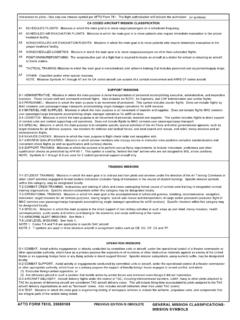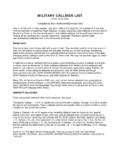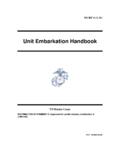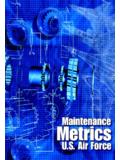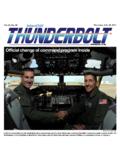Transcription of BY ORDER OF THE AIR NATIONAL GUARD …
1 BY ORDER OF THE AIR NATIONAL GUARD INSTRUCTION. CHIEF, NATIONAL GUARD BUREAU 10-201. 18 FEBRUARY 2016. Incorporating Change 1, 24 APRIL 2017. Operations AIR TRANSPORTATION. COMPLIANCE WITH THIS PUBLICATION IS MANDATORY. ACCESSIBILITY: Publications and forms are available on the e-Publishing website at for downloading or ordering. RELEASABILITY: There are no releasibility restrictions for this publication. OPR: NGB/A3MT Certified by: NGB/A3. (BG Dawne L. Deskins). Supersedes: ANGI10-201, 18 December Pages: 58. 2007. This instruction prescribes the policy for the use of Air NATIONAL GUARD (ANG) airlift resources and implements the Air NATIONAL GUARD 's Mission Readiness airlift (MRA) program. It gives guidance on the standard process for requesting ANG Operational Support airlift (OSA), airlift for training from the ANG MRA Program and Joint Airborne/Air Transportability Training (JA/ATT). This instruction provides the user community with a single source of information on the entire ANG airlift system.
2 This instruction applies to the ANG, Army NATIONAL GUARD (ARNG), and potential users. It is primarily aimed at logistics and scheduling offices in the ANG and ARNG field units. This regulation augments and expands on information contained in Department of Defense (DoD). , Air Transportation Eligibility and DoD Directive , DoD policy on the Use of Government aircraft and Air Travel. It does not replace those references. Ensure that all records created as a result of processes prescribed in this publication are maintained in accordance with (IAW) Air Force Manual (AFMAN) 33-363, Management of Records, and disposed of IAW Air Force Records Disposition Schedule (RDS) located in the Air Force Records Information Management System (AFRIMS). The proponent agency for this instruction is the ANG. Operational Plans and Execution Division (NGB/A3MT). Users are invited to send comments and suggested improvements on Air Force (AF) Information Management Tool (IMT) 847, Recommended Changes to Publications, directly to Air NATIONAL GUARD , Operational Plans and Execution Division (NGB/A3MT), 3500 Fetchet Avenue, Joint Base Andrews, MD 20762- 5157.
3 This instruction does not meet tier level waiver requirements IAW AFI 33-360. Waiver requests are strictly worked through the Mission Readiness airlift (MRA) office. 2 ANGI10-201 18 FEBRUARY 2016. SUMMARY OF CHANGES. This interim change revises ANGI 10-201 by (1) recommending 30 day coordination for ARNG. missions on fees associated with the mission, (2) adds Unit Training Assembles (UTA) to Priority 5, (3) corrected paragraph references, (4) remove C-38 from the publication, (5) local training area defined in AFI 11 Series, Volume 3, Wing Supplement, Operational Procedures. A. margin bar (|) indicates newly revised material. Chapter 1 TRANSPORTATION POLICIES FOR USE OF ANG aircraft 5. 5. Joint Doctrine - Transportation.. 5. DoD Transportation Policy.. 5. Passenger/Cargo Eligibility Options Outside Standard Channels.. 6. United States Air Force (USAF) and Air Mobility Command (AMC). Transportation Policy.. 7. NATIONAL GUARD Bureau (NGB) Transportation Policy.. 7. Non-Standard airlift Requests, Travel for Conferences, Conventions, Staff Assistance Visits, Meetings, and/or MWR Events.
4 9. Emergency Response .. 10. Transportation of mobilized Airmen/Soldiers in Title 10 10. Chapter 2 ANG MISSION READINESS airlift (MRA) PROGRAM 11. 11. Dedicated aircraft Support.. 12. Reimbursement Policy.. 13. MRA Allocation.. 16. Minimum Qualifications for MRA.. 16. MRA Priority System.. 17. NGB Validator's Prioritization Matrix.. 18. MRA Request Submission Deadline.. 19. Annual MRA Scheduling Cycle.. 20. Table Annual MRA Scheduling Cycle.. 20. airlift Allocation Council Process.. 20. ANGI10-201 18 FEBRUARY 2016 3. MRA Status Information.. 21. Mission Cancellation and/or Changes.. 22. Disposition of Unfilled Requests.. 22. Chapter 3 MISSION READINESS airlift (MRA) REQUEST PROCEDURES 24. Long Range 24. General User Responsibilities.. 24. Mission Readiness airlift Process.. 25. airlift 25. Chapter 4 FLIGHT OPERATIONS 28. Command and Control.. 28. ANG Mission 28. Unit Generated Mission Identifiers.. 28. Mission Planning.. 29. Waiver Authority.. 29. Maximum Crew Rest.. 29. Phoenix Raven Support.
5 29. Pre-Mission Itineraries.. 30. Flight Following.. 30. After-Action Reporting.. 31. GDSS 32. Chapter 5 ANG OPERATIONAL SUPPORT airlift (OSA) MANAGEMENT 33. 33. CONUS OSA.. 33. OCONUS OSA.. 33. ANG Mission Number Validation Authority .. 34. OCONUS OSA User Responsibility .. 34. Passenger Eligibility for OCONUS OSA.. 35. Minimum Passenger Requirements.. 35. Submission Form Instructions (DD Form 2768) .. 35. 4 ANGI10-201 18 FEBRUARY 2016. General User Responsibilities.. 38. Chapter 6 JOINT AIRBORNE / AIR TRANSPORTABILITY TRAINING (JA/ATT) 39. 39. JA/ATT Program Description.. 39. JA/ATT Mission Validation and Scheduling.. 40. JA/ATT Mission Reimbursement.. 40. Attachment 1 GLOSSARY OF REFERENCES AND SUPPORTING INFORMATION 42. Attachment 2 NGB/A3M MISSION NUMBER MATRIX 53. Attachment 3 WEEKLY/WEEKEND DEDICATED CHECKLIST 55. Attachment 4 aircraft DATA 56. ANGI10-201 18 FEBRUARY 2016 5. Chapter 1. TRANSPORTATION POLICIES FOR USE OF ANG aircraft . Purpose. This section outlines transportation policy and the management of military airlift resources possessed by the ANG.
6 Joint Doctrine - Transportation. The Chairman Joint Chiefs of Staff (CJCS) outlines transportation doctrine and guidance in Joint Publication 4-01, Joint Doctrine for the Defense Transportation System. The Defense Transportation System (DTS) is that portion of the nation's transportation infrastructure, which supports the DoD common-user transportation needs across the range of military operations. The ANG does not fall under the DTS. Transportation procedures and responsibilities should be the same for peacetime and wartime. This standardization allows transportation forces to train during times of peace in the same manner in which they would operate during war or a contingency and provides flexibility to effectively and quickly support any type of military operation. The foundation for transportation policy is based on two statutes of United States Code (USC). USC, Title 31, Section 1344, Passenger Carrier Use, states that vehicles and aircraft of any United States (US) Government agency may only be used for official purposes.
7 USC, Title 31, Section 1301, Anti-Deficiency Act, states that appropriated funds may only be used for the purposes intended, , DoD resources specifically may only be used to support DoD mission training requirements. The CJCS assigns movement priorities in support of DoD components based upon capabilities reported by USTRANSCOM and adjudicates competing lift requirements. DoD Transportation Policy. The Secretary of Defense (SECDEF) has designated the Commander, US Transportation Command as the DoD single manager for transportation (other than for Service-unique and theater assigned assets) during times of peace and war. Department of Defense policy concerning the purposes on which DoD owned or controlled aircraft can be used is set forth in DoD Directive (DoDD) , DoD Policy on the Use of Government aircraft and Air Travel. DoDD specifies that within the Continental United States (CONUS), commercial transportation services shall be the normal method used for official passenger movement including travel for attending conferences, meetings, ceremonies, giving speeches, site visits, etc.
8 Outside the Continental United States (OCONUS), commercial air transportation shall be used in accordance with the Joint Federal Travel Regulation (JFTR) Volume 1, Uniformed Service Members, and the Joint Travel Regulation (JTR), Volume 2, Department of Defense Civilian Personnel, and travel is funded by the user's organization. 6 ANGI10-201 18 FEBRUARY 2016. USTRANSCOM J3/J4 Division manages the Joint Operational Support airlift Center (JOSAC) who has been designated by the Office of the Secretary of Defense (OSD) as the executive agent for military air (MilAir) travel within the CONUS for official business. The NATIONAL GUARD will establish specific agreements identifying those specific OSA aircraft that will provide availability to JOSAC for CONUS scheduling. Contact info as follows: or call 576 2824/1768. Within the NATIONAL GUARD , each state is responsible to train at least one requestor/validator on the Joint Air Logistics Information System (JALIS) computer program. NATIONAL GUARD customers interested in using OSA aircraft for official travel within the CONUS must process their request through their state validator who will interface with JOSAC.
9 NATIONAL GUARD customers interested in using ANG OSA aircraft for official travel OCONUS must process their request through the Chief, NATIONAL GUARD Bureau (NGB), Executive Travel Coordinator (NGB-ZAS). Follow the procedures listed in Chapter 5. Active Component customers interested in using ANG OSA aircraft for official travel OCONUS must provide an authorized and validated request to ANG. Operational Plans and Execution Branch (NGB/A3MT) and NGB-ZAS. Follow the procedures listed in Chapter 5. All requests for OCONUS travel will be subject to prioritization and will be determined on ANG ability to fund or the user's ability to fund. The DoD policy for passenger transportation eligibility on DoD owned or controlled aircraft is set forth in DoD Air Transportation Eligibility and is strictly enforced by the ANG. DoD Air Transportation Eligibility delineates who is eligible for DoD transportation and under what circumstance they may travel on DoD assets. If a passenger's eligibility is not specifically addressed, then the passenger must procure an approval.
10 Applicant may seek approval or a waiver pursuant to Assistant Deputy under Secretary of Defense (Transportation Policy) procedures. It is DoD policy that commanders at all levels exercise prudent judgment to ensure that only authorized traffic is transported and that they do not misuse the authority delegated to them. All officials responding to requests for transportation not specifically authorized by DoD Air Transportation Eligibility shall make no commitments concerning prospective travelers or cargo until the potential user obtains all required approvals and the flying unit must then obtain the required ANG approval. Passenger/Cargo Eligibility Options Outside Standard Channels. The DoD is prohibited by law from providing airlift for any non DoD activity unless it is: (1) of an immediate emergency/lifesaving nature, (2) in direct support of the DoD. mission, (3) specifically authorized by statute, or (4) it is requested by the head of an executive agency of the federal government.










